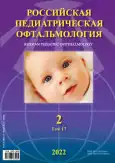Structure of iris neoplasms in children and adolescents
- 作者: Saakyan S.V.1,2, Svirina I.V.1, Tsygankov A.J.1,2, Myakoshina E.B.1,2, Kiseleva T.N.1, Lugovkina K.V.1
-
隶属关系:
- Helmholtz National Medical Research Center of Eye Diseases
- Moscow State Medical and Dental University named after A.I. Evdokimov
- 期: 卷 17, 编号 2 (2022)
- 页面: 21-30
- 栏目: Clinical recommendations
- URL: https://journal-vniispk.ru/1993-1859/article/view/106631
- DOI: https://doi.org/10.17816/rpoj106631
- ID: 106631
如何引用文章
详细
AIM: To describe clinical cases of iris neoplasms in children and adolescents.
MATERIAL AND METHODS: The study was based on retrospective and prospective analyses of children and adolescents with iris neoplasia from January 2018 to April 2022. During this period, 44 children with suspected iris neoplasia, including 20 boys and 24 girls, applied to the outpatient department; their ages ranged from 6 months to 17 years (9.1±5 years). The diagnosis was based on a comprehensive examination of patients including clinical and instrumental methods. Biomicroscopy, ultrasound investigation including ultrasound biomicroscopy, and when necessary, optical coherence tomography of the anterior eye region were performed. When it was impossible to establish the diagnosis due to the child’s age, the examination was performed under general anesthesia in the ocular oncology and radiology department.
RESULTS: Of the 44 iris lesions, nevus was found in 32 (72.7%) patients, iris melanosis in 3 (6.8%), cysts in 5 (11.3%), heterochromia in 1 (2.3%), floccula in 1 (2.3%), hamartroma in 1 (2,3%), and melanocytoma in1 (2,3%). The majority of the patients with these lesions are observed in the outpatient department. From January 2018 to April 2022, six children with iris lesions were examined in the department of ophthalmo-oncology and radiology under general anesthesia; accordingly, two children received dynamic observation, two underwent iridectomy, and two others underwent YAG-laser cystotomy and cystodestruction. Two iridectomies were also performed among adolescents. Histological diagnosis was verified in four patients after iridectomy: iris stromal cyst, iris pigment epithelium cyst, melanocytoma, and iris spindle cell nevi were detected.
CONCLUSION: According to the observation data, iris nevi were most common (72.7%), followed by cysts (11.3%) and melanosis (6.8%) of the iris. Heterochromia, floccules, and hamartomas, and melanocytoma of the iris had equal frequency (2.3%).
作者简介
Svetlana Saakyan
Helmholtz National Medical Research Center of Eye Diseases; Moscow State Medical and Dental University named after A.I. Evdokimov
Email: svsaakyan@yandex.ru
ORCID iD: 0000-0001-8591-428X
SPIN 代码: 4783-9193
Corresponding member of RAS, MD, Dr. Sci. (Med.), Professor
俄罗斯联邦, Moscow; MoscowIrina Svirina
Helmholtz National Medical Research Center of Eye Diseases
编辑信件的主要联系方式.
Email: dr.svirinairina@yandex.ru
ORCID iD: 0000-0001-7830-1880
MD
俄罗斯联邦, MoscowAlexander Tsygankov
Helmholtz National Medical Research Center of Eye Diseases; Moscow State Medical and Dental University named after A.I. Evdokimov
Email: alextsygankov1986@yandex.ru
ORCID iD: 0000-0001-9475-3545
SPIN 代码: 6476-4740
MD, PhD
俄罗斯联邦, Moscow; MoscowElena Myakoshina
Helmholtz National Medical Research Center of Eye Diseases; Moscow State Medical and Dental University named after A.I. Evdokimov
Email: Myakoshina@mail.ru
ORCID iD: 0000-0002-2087-7155
MD, PhD
俄罗斯联邦, Moscow; MoscowTatyana Kiseleva
Helmholtz National Medical Research Center of Eye Diseases
Email: dr.svirinairina@yandex.ru
ORCID iD: 0000-0002-9185-6407
MD, Dr. Sci. (Med.), Professor
俄罗斯联邦, MoscowKseniya Lugovkina
Helmholtz National Medical Research Center of Eye Diseases
Email: ksushalyg@mail.ru
ORCID iD: 0000-0002-3531-3846
MD, PhD
俄罗斯联邦, Moscow参考
- Shields CL, Kaliki S, Hutchinson A, et al. Iris nevus growth into melanoma: analysis of 1611 consecutive eyes: the ABCDEF guide. Ophthalmology. 2013;120(4):766–772. doi: 10.1016/j.ophtha.2012.09.042
- Demirci H, Mashayekhi A, Shields CL, et al. Iris melanocytoma: clinical features and natural course in 47 cases. Am J Ophthalmol. 2005;139(3):468–475. doi: 10.1016/j.ajo.2004.10.008
- Pogrzebielski A, Orlowska-Heitzman J, Romanowska-Dixon B. Uveal melanoma in young patients. Graefes Arch Clin Exp Ophthalmol. 2006;244(12):1646–1649. doi: 10.1007/s00417-006-0347-x
- Saakyan SV, Amiryan AG, Tsygankov AY. Uveal melanoma in the children and adolescents: the analysis of the original observations of 21 patients. Russian pediatric ophthalmology. 2015;10(3):33–36. (In Russ). doi: 10.17816/rpoj37679
- Lois N, Shields CL, Shields JA, Mercado G. Primary cysts of the iris pigment epithelium. Clinical features and natural course in 234 patients. Ophthalmology. 1998;105(10):1879–1885. doi: 10.1016/S0161-6420(98)91034-X
- Shields CL, Kaliki S, Shah SU, et al. Iris melanoma: features and prognosis in 317 children and adults. J AAPOS. 2012;16(1):10–16. doi: 10.1016/j.jaapos.2011.10.012
- Barr CC, McLean IW, Zimmerman LE. Uveal melanoma in children and adolescents. Arch Ophthalmol. 1981;99(12):2133–2136. doi: 10.1001/archopht.1981.03930021009003
- Krantz BA, Dave N, Komatsubara KM, et al. Uveal melanoma: epidemiology, etiology, and treatment of primary disease. Clin Ophthalmol. 2017;11:279–289. doi: 10.2147/OPTH.S89591
- Shields JA, Sanborn GE, Augsburger JJ. The differential diagnosis of malignant melanoma of the iris. A clinical study of 200 patients. Ophthalmology. 1983;90(6):716–720. doi: 10.1016/s0161-6420(83)34500-0
- Shields JA. Primary cysts of the iris. Trans Am Ophthalmol Soc. 1981;79:771–809. PMC1312203
- Arestova NN, Katargina LA. Laser surgery of the anterior eye segment cyst in children. Russian Ophthalmological Journal. 2011;4(3):25–30. (In Russ).
- Shields JA, Shields CL. Melanocytic tumors of the iris. In: Shields JA, Shields CL. Intraocular tumors. A text and atlas. Philadelphia: WB Saunders; 1993. P:65.
- Singh AD, Shields JA, Eagle RC, et al. Iris melanoma in a ten-year-old boy with familial atypical mole-melanoma (FAM-M) syndrome. Ophthalmic Genet. 1994;15(3-4):145–149. doi: 10.3109/13816819409057842
- McLaughlin JP, Fung AT, Shields JA, Shields CL. Iris melanoma in children: Current approach to management. Oman J Ophthalmol. 2013;6(1):53–55. doi: 10.4103/0974-620X.111920
- Tran TA, Hirst LW, Axelsen RA, Welch R. Iris melanoma in 12-year-old boy. Clin Exp Ophthalmol. 2006;34(5):489–490. doi: 10.1111/j.1442-9071.2006.01252.x
- Al-Kharashi A, Alsakran WA, Alshamrani AA, et al. Iris Melanocytoma in a Child: Clinical and Histopathological Findings. Am J Case Rep. 2021;22:e931385. doi: 10.12659/AJCR.931385
- Zargar S, Prendiville KJ, Martinez E. Iris pigment epithelial cysts in a newborn. GMS Ophthalmol Cases. 2016;6:Doc07. doi: 10.3205/oc000044
- Arestova NN, Egiyan NS. Laser treatment of giant iris cyst in the anterior chamber in a child (a clinical observation). Vestn Oftalmol. 2018;134(5):86–91. (In Russ). doi: 10.17116/oftalma201813405186
补充文件




















